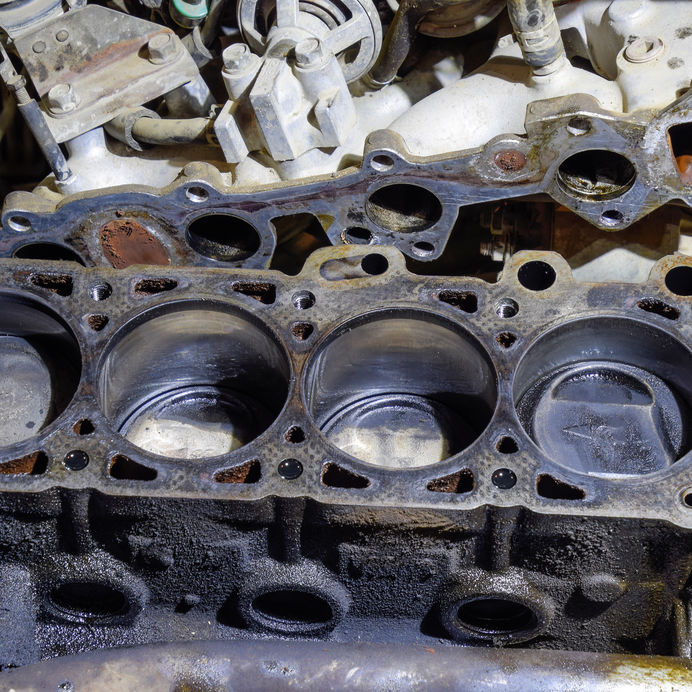
Gasket issues
To discuss what happens when a gasket head blows, let’s get a definition on What is a gasket head, first. You already know that a car’s engine is several components that all work together in some form or fashion, each just as important at the others. A gasket head is one of those components, internally.
A gasket head is located sandwiched between the cylinder head and the engine block. It is small and it is a vital component. Why is the gasket head important? Because it seals the internal combustion process that allows coolant and oil throughout the engine. When the coolant and oil can’t circulate, the engine can become overheated and warped.
A gasket head also seals the combustion chamber inside the engine, allowing the vehicle to create enough power to move forward. The gasket head also directs the harmful gases to exit through the exhaust system and not the combustion chamber. So, when your mechanic tells you that your car has a blown gasket head, you’ll know you got a major, expensive problem.
What are the first signs of a blown gasket head?
There are three fluids that are vital for a car’s engine: coolant, fuel, and motor oil. With a blown gasket head, all of these fluids can leak into and out of combustion chamber. You’ll notice the following when this happens:
- Overheating : The engine will overheat because there isn’t any coolant in the engine compartments or there are hydrocarbons in the cooling system.
- Smoke: A blue, grey, or white smoke is indication that the combustion chamber has coolant and/or oil inside.
- Power: There is a loss of power with the engine, its sputtering, and the car is using a lot of fuel because there is no compression in the engine.
- Oil Discolored: The oil looks like chocolate milk is indicative of coolant has leaked into the oil.
How do you check for a blown gasket head?
There is a few common ways on how to tell a gasket head is busted. The vehicle needs to be parked on level ground, with the parking brake set and the engine cold. Now follow these six steps that will tell you if your have a gasket head blown:
- STEP ONE: Remove the oil cap if you see a brown milky substance collected on the cap bottom, there is coolant and water in the oil. This is usually from a cracked cylinder head, block or a leaking manifold, or leaking intake gasket head.
- STEP TWO: Check combustion chamber for coolant in and around the cylinder head and engine block. Remove the spark plugs one at a time. If there is water inside the spark plugs, you have a gasket head leak.
- STEP three: Reinstall the spark plugs and while the engine is cool, take the radiator cap off then start the engine. Look for continuous bubbles inside the radiator while the car is running.
- STEP FOUR: To confirm gasket head problem, the block or engine head are cracked, drain some of the coolant out of the radiator and using a chemical tester (available at local auto parts stores), place the test tube in that fluid you drain. Yellow on the tester indicates gasket head is blown. Blue on the tester, gasket is good. This is not a 100% dependable test, which is why the other steps we’ve provided here are important to perform too.
- STEP FIVE: A gasket head can fail between cylinders causing them to misfire and have low compression. This can be confirmed by removing all the spark plugs and test every cylinder. If there is a low reading on two or more cylinders, your car needs a new gasket head.
- STEP 6: With some engines, the gasket head is where the coolant and oil pass through in their own ports. When the gasket head is blown, the run into each other’s port.
Can you fix a blown head gasket?
Yes, most of the time, an experienced mechanic will know how to repair a blown gasket head. However, there are times that severe damage has occurred when the gasket head blew that may require some other repairs be completed first.

How hard is it to replace a head gasket?
For an experienced mechanic, no, replacing a gasket head can be done in half a day or so. For you and a friend, or a shade tree mechanic, it could take an entire weekend.
Is it worth fixing a blown gasket head?
Yes, it is most cases, and in all cases, you need to address the issue and not keep driving the car with a blown gasket head. When a blown gasket head is ignored, the cascading effect of damage will seem never ending, and will definitely be expensive. Call 630-932-4427 today.
